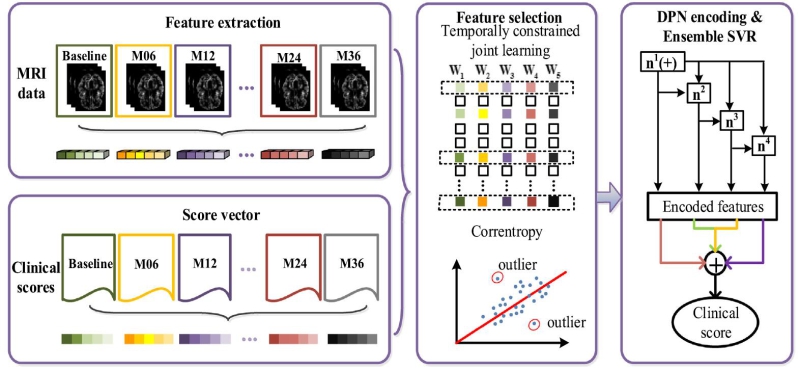
Alzheimer’s disease (AD) is a type of brain disorder that causes problems with memory, thinking and behavior.
During the past few decades, scientists employed the patterns in neuroimaging data, such as positron emission topography (PET) and magnetic resonance imaging (MRI), to predict AD.
However, most previous studies were focused on a single time point without considering relationship between MRI/PET data and clinical scores at multiple time points.
Researchers from the Shenzhen Institutes of Advanced Technology (SIAT) of the Chinese Academy of Sciences designed a novel combined machine learning and deep learning framework (named as CTDE) to predict clinical scores, which effectively revealed the relationship between clinical score and neuroimaging data. The study was published in Pattern Recognition.
The regression framework developed a feature selection method based on the correntropy, temporally constrained group LASSO, and feature encoding in deep polynomial network (DPN) to realize the longitudinal clinical score prediction.
Researchers employed the CTDE in two scenarios, predictions with baseline dataset and predictions with longitudinal dataset, to predict the scores with the dataset obtained from Alzheimer’s Disease Neuroimaging Initiative (ADNI) database.
The results demonstrated that the combination of correntropy regularized joint learning and DPN promoted the advantages of each other in the sense of increasing the prediction accuracy and discovering AD biomarkers.
The comparison experiment between the CTDE and state-of-the-art methods showed that the proposed CTDE model achieved the best performance.
"One key advantage of our framework is that we utilized all the previous time points dataset to obtain the predicted scores at the next time point, which can improve the score prediction’s accuracy," said Prof. WANG Shuqiang, corresponding author of the study. "But still, other relevant clinical details, such as gender, education level and physiological factors of AD were not taken into account in this experiment. For further improving the clinical scores prediction performance, we will try to conduct more sophisticated feature selection and encoding methods in the next step."

Flowchart of the proposed method with deep and joint learning (Image by WANG Shuqiang)

86-10-68597521 (day)
86-10-68597289 (night)

52 Sanlihe Rd., Xicheng District,
Beijing, China (100864)

